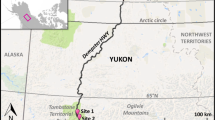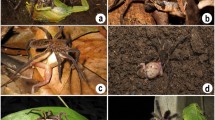Summary
In an analysis of 67 pitfall trap studies in different environments a positive correlation is found between the abundance of spiders and their potential prey, individual main prey groups and individual predator groups. The body-size of spiders and potential prey is significantly correlated both during the day in one locality and between five different localities. Spiders match the size spectrum of their potential prey by an almost equally broad spectrum, whilst the size spectrum of other predator groups is narrower. Therefore, in all size classes spiders exercise optimal predator pressure upon their potential prey. It is suggested that there may be a significant role for spiders as a multi-predator complex in reducing a multi-prey complex.
Similar content being viewed by others
References
Balch R (1953) Current practices and future trends in forest insect control. For Chron 29:6–13
Basedow T (1973) Der Einfluß epigäischer Raubarthropoden auf die Abundanz phytophager Insekten in der Agrarlandschaft. Pedobiologia 13:410–422
Boness M (1958) Biocoenotische Untersuchungen über die Tierwelt von Klee- und Luzernefeldern. Z Morphol Oekol Tiere 47:309–373
Bosch R van den (1971) Biological control of insects. Annu Rev Ecol Syst 2:45–66
Buchar J (1968) Analyse der Wiesenarachnofauna. Acta Univ Carol Biol 289:318
Buchli H (1969) Hunting Behavior in the Ctenizidae. Am Zool 9:175–193
Burghardt G (1964) Effects of prey size and movements on the feeding behavior of the lizards Anolis caroliniensis and Eumeces fasciatus. Copeia 3:576–578
Chant D (1956) Predaceous spiders in orchards in south-eastern England. J Hortic Sci 31:35–46
Coppel H (1977) Biological insect pest suppression. Springer, Berlin Heidelberg New York, p 115
Dabrowska-Prot E, Luczak L, Tarwid K (1968) Studies on the incidence of mosquitoes in the food of Tetragnatha montana and its food activity in the natural habitat. Ekol Pol A 16:843–885
Droste M, Nentwig W, Vogel M (1980) Faunistisch-ökologische Untersuchungen in einem Niederungsmoor (Schweinsberger Moor). Marburger Entomol Publ 1 (3):1–58
Duffey E (1974) Comparative sampling methods for grassland spiders. Bull Br Arachnol Soc (Stockport) 3:34–37
Duffey E (1978) Ecological strategies in spiders including some characteristics of species in pioneer and mature habitats. Symp Zool Soc Lond 42:109–123
Enders F (1975) The influence of hunting manner on prey size, particularly in spiders with long attack distances (Araneidae, Linyphiidae and Salticidae). Am Nat 109:737–763
Erber K (1978) Untersuchung der Makrofauna des Waldbodens anhand dreier verschiedener Biotope. Facharbeit Biologie, Gießen
Geiler H (1963) Die Spinnen- und Weberknechtfauna nordwestsächsischer Felder. Z Angew Zool 50:257–272
Gettmann W (1976) Prey capture in wolf spiders of the genus Pirata (Lycosidae). Entomol Ger 3:93–99
Guttmann R (1979) Untersuchungen zur Entwicklung der Bodenfauna rekultivierter Schutthalden eines Stahlwerkes. Dissertation, Naturwissenschaftliche Fakultät TU Braunschweig
Heydemann B (1961) Untersuchungen über die Aktivitäts- und Besiedlungsdichte bei epigäischen Spinnen. Verh Dtsch Zool Ges p 538–556
Hinz W (1976) Zur Ökologie der Tundra Zentralspitsbergens. Nor Polarinst 163:1–47
Holling C (1964) The analysis of complex population processes. Can Entomol 96:335–347
Horstmann K (1973) Untersuchungen zur Größenverteilung bei den Außendienstarbeiterinnen der Waldameise Formica polyctena. Waldhygiene 9:133–201
Jackson R (1977) Prey of the jumping spider Phidippus johnsoni (Araneae: Salticidae). J Arachnol (Lubbock) 5:145–149
Kiritani K, Kawahara S, Sasaba T, Nakasuji F (1972) Quantitative evaluation of predation by spiders on the green rice leafhopper, Nephotettix cincticeps Uhler, by a sightcount method. Res Popul Ecol (Kyoto) 13:187–200
Klausnitzer B, Joost W, Wolff H (1980) Faunistisch-ökologische Untersuchungen auf dem Neuen Müllberg Leipzig-Möckern. Wiss Z Karl-Marx-Univ Leipzig 29:646–652
Kobayashi S (1975) The effect of Drosophila release on the spider population in a paddy field. Appl Entomol Zool 10:268–274
Koponen S, Ojala M (1975) Quantitative study of invertebrate groups in the soil and ground layer of the IBP sites at Kevo, northern Finland. Rep Kevo Subarct Res Stn (Turku) 12:45–52
Littel A (1974) An investigation on trampling in a dune valley. Verkenningen I.v.M.-V.U. (Amsterdam) Ser B 5:1–17
Luczak J (1979) Spiders in agrocoenoses. Pol Ecol Stud 5:151–200
Markl H (1972) Aggression und Beuteverhalten bei Piranhas (Serra salminae, Characidae). Z Tierpsychol 30:190–216
Moulder B, Reichle D (1972) Significance of spider predation in the energy dynamics of forest-floor arthropod communities. Ecol Monogr 42:473–498
Müller P, Klomann U, Nagel P, Reis H, Schäfer A (1975) Indikatorwert unterschiedlicher biotischer Diversität im Verdichtungsraum von Saarbrücken. Verh Ges Ökol Erlangen 1974 p 113–128
Nakamura K (1974) A model of the functional response of a predator to prey density involving the hunger effect. Oecologia (Berlin) 16:265–278
Nentwig W (1980) The selective prey of linyphiid-like spiders and of their space webs. Oecologia (Berlin) 45:236–243
Nentwig W (1982) Zur Biologie der Schilfsackspinne Clubiona phragmitis C.L. Koch 1843 (Araneae, Clubionidae). Entomol Abh (Dres) 45: in press
Nyffeler M, Benz G (1979) Zur ökologischen Bedeutung der Spinnen der Vegetationsschicht von Getreide- und Rapsfeldern bei Zürich (Schweiz). Z Angew Entomol 87:348–376
Østbye E, Hagvar S, Haande K, Haande P, Melaen J, Skartveit A (1978) Pitfall catches of surface-active arthropods in some high mountain habitats at Finse, south Norway. Norw J Entomol 25:189–220
Remmert H (1981) Body size of terrestrial arthropods and biomass in relation to the abiotic parameters of their milieu. Oecologia (Berlin) 50:12–13
Riechert S (1974) Thoughts on the ecological significance of spiders. Biol Sci 24:352–356
Ruppertshofen H (1964) Über den Einsatz von Decken- und Radnetzspinnen im Forstschutz. Waldhygiene 5:147–153
Schaefer M (1976) Trophische Beziehungen in einem Küstendünen-Ökosystem, einer “Natürlichen Monokultur” von Ammophila arenaria. Verh Ges Ökol
Schaefer M (1978) Some experiments on the regulation of population density in the spider Floronia bucculenta (Araneae: Linyphiidae). Symp Zool Soc London 42:203–210
Schneider D (1977) Die Tierwelt des Fagetums im Botanischen Garten nach Fallenfängen im Sommer 1977 und Experimente zur Biotopbindung charakteristischer Tiere. Hausarbeit im Fach Biologie, Universität Marburg
Simon H (1964) Zur Ernährungsbiologie collembolenfangender Arthropoden. Biol Zentralbl 83:273–296
Späh H (1980) Faunistisch-ökologische Untersuchungen der Carabiden- und Staphylinidenfauna verschiedener Standorte Westfalens (Coleoptera: Carabidae, Staphylinidae). Decheniana 133:33–56
Strijbosch H (1980) Mortality in a population of Bufo bufo resulting from the fly Lucilia bufonivora. Oecologia (Berlin) 45:285–286
Sturm H (1978) Zur Ökologie der andinen Paramoregion. Biogeographica 14:1–121
Tamm J (1981) Das jahresperiodisch trockenliegende Eulitoral der Edertalsperre als Lebens- und Ersatzlebensraum. Eine Ökosystemstudie mit terrestrischem Schwerpunkt. Dissertation, Fachbereich Biologie, Universität Marburg
Tretzel E (1955) Technik und Bedeutung des Fallenfanges für ökologische Untersuchungen. Zool Anz 155:276–287
Turnbull A (1962) Quantitative studies of the food of Linyphia triangularis (Araneae: Linyphiidae). Can Entomol 94:1233–1249
Turnbull A (1966) A population of spiders and their potential prey in an overgrazed pasture in Eastern Ontario. Can J Zool 44:557–583
Turner M (1979) Diet and feeding phenology of the green lynx spider Peucetia viridans (Araneae: Oxyopidae). J Arachnol 7:149–154
Uetz G (1975) Temporal and spatial variation in species diversity of wandering spiders (Araneae) in deciduous forest litter. Environ Entomol 4:719–724
Uetz G, Johnson A, Schemske D (1978) Web placement, web structure, and prey capture in orb-weaving spiders. Bull Br Arachnol Soc (Stockport) 4:141–148
Waldorf E (1976) Spider size, micro-habitat and use of food. Am Midl Nat 96:76–87
Whitcomb W, Tadic M (1963) Araneida as predators of the fall webworm. J Kans Entomol Soc 36:186–190
Wüst E (1981) Ökologische Untersuchungen in einem lichten Eichenwald. Hausarbeit im Fach Biologie, Universität Marburg
Author information
Authors and Affiliations
Rights and permissions
About this article
Cite this article
Nentwig, W. Epigeic spiders, their potential prey and competitors: Relationship between size and frequency. Oecologia 55, 130–136 (1982). https://doi.org/10.1007/BF00386728
Received:
Issue Date:
DOI: https://doi.org/10.1007/BF00386728




